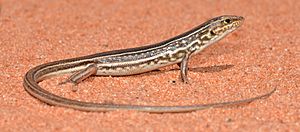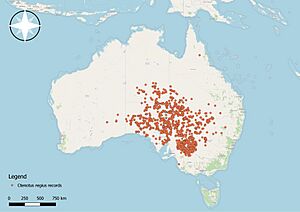Ctenotus regius facts for kids
Quick facts for kids Ctenotus regius |
|
|---|---|
 |
|
| Conservation status | |
| Scientific classification | |
| Genus: |
Ctenotus
|
| Species: |
regius
|
The pale-rumped ctenotus, also known as the regal striped skink (Ctenotus regius), is a medium-sized lizard. It is a type of skink and belongs to the Ctenotus group. This group has almost 100 different species in Australia, making it the largest group of reptiles there! You can find this skink only in the dry areas of mainland Australia.
Contents
What Does It Look Like?
The pale-rumped ctenotus is a medium-sized skink. It has stripes along its back and white spots on its sides. Its tail is a reddish-brown color. The body of the skink is a dark brownish-black.
It also has a white-cream stripe that goes from above its ear to below its eye. There are white spots on its sides, found between the stripes that run along its body.
This skink is about 7.2 cm long from its snout (nose) to its vent (where its tail starts). Female skinks are usually a little bit bigger than the males.
Where Does It Live?
The pale-rumped ctenotus is found only in Australia. It lives in specific areas across several states. These include the north-west of New South Wales and the south-west of Queensland. You can also find it in the south-east of the Northern Territory and the north-east of South Australia. Lastly, it lives in the north-west of Victoria.
Many records of this skink exist in different National Parks and Nature Reserves in New South Wales. Some of these places are Mallee Cliffs NP, Tarawi NR, Mungo NP, Sturt NP, Kinchega NP, Nocoleche NR, and Yathong NR.
Home and Habitat
The pale-rumped ctenotus lives in sandy and loamy deserts in central Australia. It likes to hide in low shrubs. These shrubs include saltbush (Atriplex spp.), bluebush (Maireana spp.), and nitre bush (Nitraria billardierei).
These skinks usually stay within a certain area, which is called their home range. Scientists estimate their home range to be about 40 to 60 meters wide.
What Does It Eat?
The pale-rumped ctenotus mainly eats insects. It is not very picky about what kind of insects it eats. Sometimes, it might also eat small amounts of plant material.
Reproduction and Life
The pale-rumped ctenotus is an egg-laying species. This means the females lay eggs instead of giving birth to live young. Females are typically larger than males.
They usually lay about two eggs early in the summer. However, the number of eggs they lay can change a lot depending on the weather and other conditions. The pale-rumped ctenotus has a fairly short life, living for about 3 years. Other Ctenotus species, like C. leonhardii, can live much longer, sometimes up to 7 years.
Conservation Status
The pale-rumped ctenotus is listed as a species of least concern on the IUCN Red List. This means it is not currently at high risk of extinction.
However, many things can affect desert reptile populations in Australia. These include losing their homes due to land clearing. Their habitats can also be damaged by introduced pest animals. Climate change caused by humans is another threat. Vehicle collisions and new diseases can also harm these skinks.



